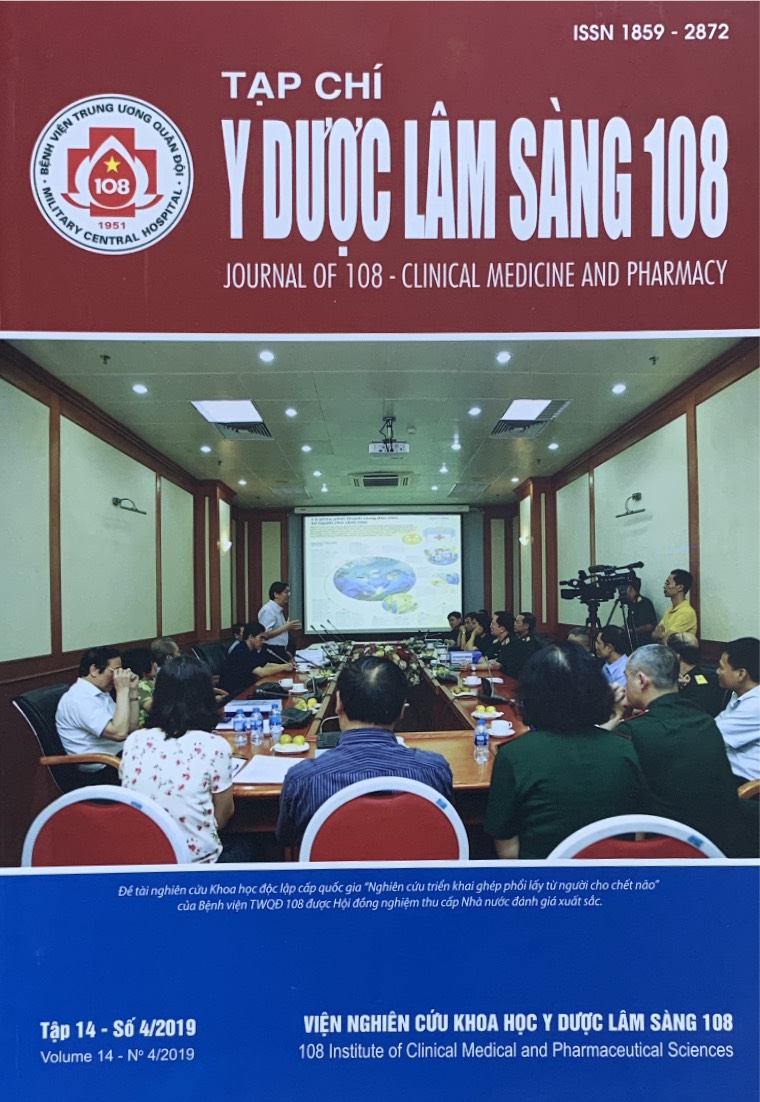Clinical, subclinical characteristics and antibiotic resistance in sepsis patients caused by Staphylococcus aureus at 108 Military Central Hospital from 2016 to 2018
Main Article Content
Keywords
Abstract
Objective: To study clinical, subclinical characteristics and antibiotic resistance in sepsis patients caused by S. aureus at 108 Military Central Hospital. Subject and method: 57 sepsis patients according to Sepsis-2 and having blood culture positive with S. aureus were recruited into this study. Result: Most patients were old age (64.9%), male (64.9%). The isolation of S. aureus originated from hospital (47.4%). The proportion of septic shock and death were 35.1%, 47.4%, respectively. Common medical comorbidities: Diabetes (42.1%), hypertension (31.6%), chronic lung diseases (29.8%). The most common primary infection was respiratory tract (43.9%), followed by skin-soft tissue (35.1%). Leukocytosis was 73.7% and 70.2% of patients had PCT > 10ng/ml. The rate of MRSA was 47.4%. The strains of S. aureus were quite sensitive to quinolon. 100% of strains were sensitive to vancomycin. The level of resistance in MRSA group was higher than that of MSSA groups, significant difference with moxifloxacin, levofloxacin, erythromycin and tetracycline. Conclusion: Sepsis caused by S. aureus had a high rate of shock and death. Nearly 50% of the isolates were MRSA.
Article Details
References
2. Nguyễn Thị Vinh (2006) Giám sát sự đề kháng kháng sinh của vi khuẩn gây bệnh thường gặp ở Việt Nam năm 2005. Tạp chí nghiên cứu Y học, Số đặc biệt, tr. 87-91.
3. Vu Quoc Dat et al (2017) Bacterial bloodstream infections in a tertiary infectious diseases hospital in Northern Vietnam: Aetiology, drug resistance, and treatment outcome. BMC infectious diseases 17(1): 493-493.
4. Will A McGuinness et al (2017) Vancomycin resistance in Staphylococcus aureus. The Yale journal of biology and medicine 90(2): 269-281.
5. Mervyn Singer et al (2016) The third international consensus definitions for sepsis and septic shock (Sepsis-3). JAMA 315(8): 801-810.
6. Henry FC, Frank RD (2009) Waves of resistance: Staphylococcus aureus in the antibiotic era. Nature Reviews Microbiology, 7 629.
7. Teruyo Ito et al (2001) Structural comparison of three types of Staphylococcal cassette chromosome integrated in the chromosome in methicillin-resistant Staphylococcus aureus. Antimicrobial Agents and Chemotherapy 45(5): 1323-1336.
8. R Köck et al (2010) Methicillin-resistant Staphylococcus aureus (MRSA): Burden of disease and control challenges in Europe. Eurosurveillance 15(41): 19688.
9. Mitchell ML et al (2003) 2001 SCCM/ESICM/ACCP/ATS/SIS international sepsis definitions conference. Intensive Care Medicine 29(4): 530-538.
 ISSN: 1859 - 2872
ISSN: 1859 - 2872
